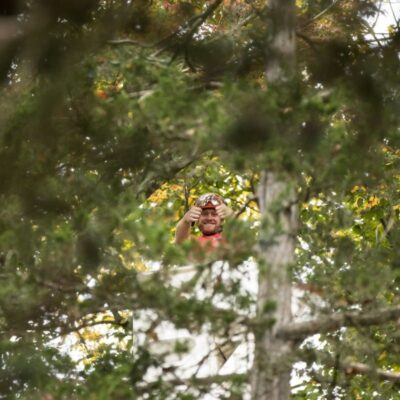Summers in the Hopkinton, MA area often bring intense thunderstorms – and with them comes lightning.
The standard advice for heading inside before a thunderstorm is to get moving as soon as you hear thunder and before you see lightning. Unfortunately, trees don’t have the option of picking up their roots to take cover.
WHY LIGHTNING STRIKES TREES
Because lightning tends to hit tall objects, trees are likely targets. They’re especially prone to lightning strikes because electricity seeks the path of least resistance, and the sap and moisture inside a tree make it a better conductor than the surrounding air.
Trees in some locations are also more vulnerable to lightning strikes, including trees;
- in an open area
- near a body of water
- on the edge of a forest or stand of trees
- on a mountainside or hilltop
- growing close to a building
- with electrical lights strung from the branches
WHAT HAPPENS WHEN LIGHTNING HITS A TREE
When lightning hits a tree, damage can range along a scale from minimally invasive to explosive.
As soon as lightning strikes the tree, water in its cells can start to boil causing steam to form. The expanding steam can explode, cracking bark or even stripping it off the tree. If the lightning strikes deep within the tree, the whole tree can blow up. It all depends on the amount of water in the tree and where it’s located – moisture deep in the sapwood often results in more catastrophic effects than does moisture on or just below the bark.
HOW TO TELL IF A TREE HAS BEEN HIT BY LIGHTNING
Evidence of a lightning strike may be obvious from shattered pieces of bark to charred areas of the trunk. And if the tree has gone up in flames, it’s pretty obvious!
But some symptoms may be hidden deep inside the tree or even in its root system.
This wide range of indicators has to do with the type, structure and health of the tree; the strength of the strike; and the amount of moisture in the tree’s cells.
WHAT TO DO IF YOUR TREE IS STRUCK BY LIGHTNING
If your tree is struck by lightning, it may survive the hit, especially if just one side shows damage.
Prune out any obviously damaged branches and remove hanging pieces of bark that can’t be put back into place.
Providing supplemental fertilization and ensuring that the tree has sufficient water helps with the uptake of nutrients to keep the tree growing strongly. A healthy tree can often heal itself after a lightning strike if the damage isn’t too severe.
Then start your watchful waiting for signs of tree stress. We recommend waiting 2 to 6 months before major corrective pruning or removing the tree. Most times it’s not the strike that kills the tree, but the resulting injury that exposes the tree to the environment, diseases, and insects.
Keep up with good tree care, such as watering, fertilizing and watching for insects.
HOW TO PREVENT LIGHTNING DAMAGE TO TREES
It’s better to protect trees from a potential lightning strike than it is to repair the damage afterward.
Lightning protection systems can be installed to protect especially valuable or vulnerable trees. These systems protect trees by slowly releasing the electrical charge and letting it dissipate before it becomes dangerous.
Although these systems can be expensive to install for tree protection, they can also help protect nearby property. A system consists of an air terminal placed in the top of the tree, a copper cable conductor that runs down the tree trunk to the ground, and a ground-rod system placed a safe distance away from the tree. If lightning should strike, the system directs the electrical current along the cable and away from the tree where it can safely dissipate into the ground.
KEEP YOURSELF SAFE TOO
Lightning can strike whenever there’s a thunderstorm, and the temperature of a lightning flash can be five times hotter than the sun. While it’s important to protect your trees from a lightning strike, it’s crucial to protect yourself first. There are hundreds of lightning fatalities every year in the USA; don’t be a statistic – follow these lightning protection tips from the Massachusetts Emergency Management Agency.
If you have any trees that you think may be vulnerable to lightning strikes, consult with the Certified Arborists at American Climbers about the pros and cons of installing a lightning protection system on your trees. This is definitely not a DIY job!
Blog Topics
Recent Posts
What's Happening? Stay Informed!
Stay on top of local events, pest and disease updates, tree and landscape tips, and more. Delivered straight to your inbox each month.










